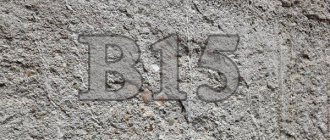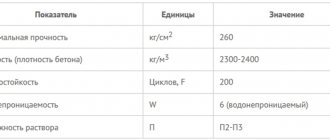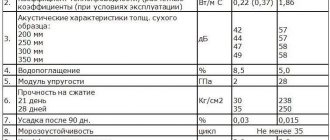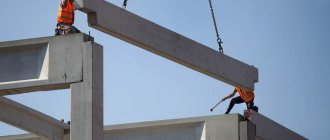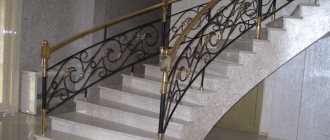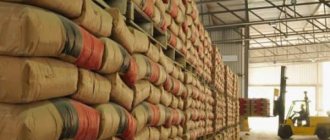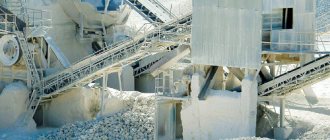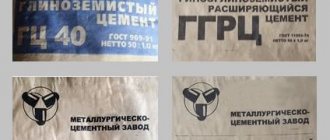Concrete is one of the most popular materials in the construction of houses and non-residential structures. It has great strength, is easy to use and has a low cost. The disadvantage of all mixtures is the need for shrinkage after pouring into the formwork and the risk of cracks and delamination. Thanks to special non-shrinking compositions, it is possible to shorten the preparatory stage and reduce the likelihood of defects. This type of solution is non-toxic and has high protection against corrosion, frost and other adverse external factors. It is used for the restoration of roads, restoration of load-bearing surfaces, staircases and floors. And it's quite simple to do.
Manufacturing and packaging
The production and packaging of cement is a long process that requires high-tech equipment and control. Its origin lies in limestone quarries. Two types of limestone are used. The first is located close to the surface, at a depth of several tens of centimeters. This is the so-called “second-grade” limestone, but it already contains iron, aluminum oxide, silicon and other minerals. They give cement mixtures unique properties.
Both types are used in production, both pure and combined in different proportions with each other and additional components. The ratio of first-class and second-class substances, as well as the type and amount of additives determine the brand and cost of cement. Limestone rock in its natural state is a solid monolith. It is broken into small fragments by explosives, placed in layers of limestone in a quarry, and then collected by loaders. The sizes of the fragments can be of different sizes, from small pebbles to an entire building block. In this form they arrive at cement factories.
At the plant, the raw materials first go to the “primary crusher”. In it, large fragments are crushed to the size of a tennis ball. In the process of grinding large fragments, water enters the crusher so that dust does not rise, and along with it the mass of limestone is not lost. The crushed stones are conveyed through a conveyor to the secondary crusher. In it, the rock is “grinded” into fragments the size of crushed stone. The first and second grades are crushed separately.
Then a raw mixture for cement of different grades is formed. After mixing, the finished “heaps” are sent to a roller mill. In the process of grinding limestone, additives are used: powdered magnesium, silicon and aluminum oxide, if they are contained in the limestone rock in insufficient quantities. The mill grinds the rock into stone flour. This stone flour then goes into the preheater. In less than a minute it heats up from 80 degrees Celsius to 800.
In the heater, unnecessary components are separated, leaving lime suitable for construction. It goes into a cylindrical firebox. The bottom of the firebox warms up to 1700 degrees. The mass inside the kiln is fused into small "glass" balls called clinkers. When leaving the oven, they are quickly cooled with a stream of cold air to 70-80 degrees. Fast is the key. If cooling occurs slowly, the mixture will be of poor quality. This is the raw material for high-quality cement.
The cooled “glass balls” undergo the last stage of processing – final crushing. In fact, this is the grinding of solid clinkers between steel balls of different diameters, of which there are about one and a half tons in one crusher. When grinding clinkers, lump gypsum is added to stone flour. It slows down the hardening process of liquid cement mortar. The powder mixture coming out of the crusher is cement. Some manufacturers add plasticizers to increase strength.
Bags of cement rarely have a small volume of 10-15 kg. Typically, the minimum weight is 25 kilograms, and the most popular is 50 kg. Bags of 50 kilograms are called slimbags. Sometimes there are non-standard volumes of 30, 35, 42, 46 kg. The packaging bag consists of several layers (from 2 to 5) of craft paper. Also common are packaging containers for construction on a production scale - big bags. These are soft containers made of polypropylene or high-strength nylon with or without stiffening ribs and linings. The weight of cement in big bags is from 300 to 3000 kg.
Big bags have a number of advantages over regular packaging:
- Wholesale purchase of cement reduces the price per 1 kg of mixture;
- soft containers have slings for loading;
- they are heavy-duty, reusable and recyclable;
- the polypropylene shell extends the shelf life because it protects the cement from the negative influence of the external environment;
- containers can be equipped with liners for heat resistance, antistatic, waterproof, and UV protection.
Crushed stone
— GOST 8267-93 Crushed stone and gravel from dense rocks for construction work. Specifications
Establishes acceptance rules and control methods for crushed stone and gravel from dense rocks.
— GOST 8269.0-97 Crushed stone and gravel from dense rocks and industrial waste for construction work. Methods of physical and mechanical tests (as amended on September 12, 2019)
Establishes the procedure for performing physical and mechanical tests.
Mixture proportions
There is a classic version of the mixture, which is determined by the ratio 1:3 - 1 part cement and 3 parts sand. Both components are first mixed dry with each other, and then water is added to this mixture in portions. All this is thoroughly mixed until a solution is formed, the consistency of which is similar to thick sour cream. Be sure to give the finished mixture 15 minutes to thicken, after which it is mixed again.
By the way, the cement-sand mortar “lives” for no more than 1.5 hours. After which it begins to lose moisture and dries out. So a small batch is a justified decision.
To mix the components, it is recommended to use a construction mixer or a drill with a special attachment. If you need a large volume of material, for example, to pour a foundation, then we recommend carrying out the preparation process in a concrete mixer
Main ingredients of the solution:
Cement is a binding component. It must be in paper bags. It is recommended to buy it before starting construction processes. That is, it must be “fresh”. After all, during long-term storage this material cakes, which means it loses its qualities. Sand is a filler. There is one point regarding quality here. There should be no foreign materials in the sand. This is especially true for clay. Therefore, it is recommended to purchase river sand
The coarse fraction is not used for preparing plaster, although it works great in foundation mortars. Water is the basis, so it must be clean. The main requirement for it is the absence of acid and oil impurities.
Features of choosing a brand of solution
Now you can move on to the proportions and understand such an indicator as the brand of solution:
- The masonry composition is grade M100. It is used in the construction of walls and barrier structures made of bricks or blocks based on different materials. To do this, you will need M400 cement and sand, which are mixed in a ratio of 1:4.
- To increase the strength of the masonry, you can use M200 grade mortar. To do this, you will have to reduce the amount of sand by 2 times.
- To level the floor bases, the M300 grade of mortar is used. To do this, you can use cement M400 or M500 with the addition of water and sand in a ratio of 1:3:0.5.
- To plaster the walls, use exactly the same solution as above, only with a slight increase in the amount of cement. For example, it could be 1.2-1.5. Plaster mortars are often made with the addition of lime milk. This reduces the strength of the material, but increases its ductility. In this case, the cement-sand-milk ratio will be 1:5:2.
Standard proportions
There are certain technological standards that regulate the ratio of building mixture components. Here are three examples:
- To prepare the screed solution, use proportions of 1:2-1:6. In this case, the amount of water is not indicated, but only the cement-sand ratio is indicated.
- In low-rise construction, 1:3 or 1:4 solutions are most often used.
- For erected structures - from 1:3 to 1:6.
Why don't the standards specify water? The fact is that it is easy to make a mistake with the volume of water. After all, the sand may be wet, and it is impossible to determine the degree of humidity at home. At the factory, this indicator is strictly controlled. What can you offer to those who use handmade solutions? To do this, it is better to double the batch if the first one turns out to be liquid. Just add cement and sand to it according to the standard, but reduce the amount of water.
Today, facing tiles and stone are placed on ready-made adhesive mixtures, which greatly simplifies the process of preparing the composition. But since we are considering all cement-sand mortars, we should not ignore this masonry material. Let's just designate the proportions - 1:2.4:0.4. This is such a non-standard ratio.
6 Control methods
6.1 The strength of concrete is determined according to GOST 10180, GOST 22783, GOST 28570, GOST 22690, GOST 17624, GOST 31914.
The strength of concrete is controlled and assessed according to GOST 18105 and GOST 31914.
6.2 Frost resistance of concrete is determined and assessed according to GOST 10060.
6.3 The water resistance of concrete is determined and assessed according to GOST 12730.5, GOST 31914.
6.4 Concrete abrasion is determined according to GOST 13087 and assessed according to GOST 13015.
6.5 The average density of concrete is determined according to GOST 12730.1, GOST 17623.
6.6 Control of concrete according to additionally established quality indicators (shrinkage deformation, creep, heat generation during hardening, prismatic strength, elastic modulus, endurance, crack resistance, etc.) is carried out according to the methods established in GOST 24544, GOST 24316, GOST 24452, GOST 24545, GOST 29167, respectively, or in other regulatory and technical documents approved in the prescribed manner.
6.7 In the absence of standard methods for determining additional quality indicators, test methods are developed in specialized research organizations in the prescribed manner, agreed upon with the design organization and indicated in the technical documentation.
6.8 The specific effective activity of natural radionuclides in materials for preparing a concrete mixture is determined according to GOST 30108.
Production Features
As soon as people began to build houses, they began to need a composition that could hold together stones and other building materials. At first it was ordinary clay, but such dwellings were short-lived, and the building itself looked very unpresentable.
A little later, builders discovered that lime mortar also has some binding characteristics - this discovery was made by the ancient Greeks and Romans, and the latter noticed that if volcanic ash is added to lime, the masonry becomes truly monolithic.
Lime was also used in Rus', mixing it with clay and water. At the beginning of the 19th century, a building mixture was experimentally created, which in its parameters is close to modern compositions.
So, cement is the definition of a material consisting of the components clay and limestone. They are mixed with each other and subjected to long-term heat treatment, after which the resulting mass is ground to a powdery state.
The mixture has a gray tint and, when combined with water, forms a solution that, when dried, becomes hard as a rock. Its exclusive feature is that the mass hardens only in conditions of high humidity, and this process can even occur under water. This, by the way, is the main difference between cement and many other binders.
For example, gypsum and air-lime gain strength only in air. And as part of concrete, it hardens not so much because the water evaporates, but due to its reaction with the powder: at this moment, heat is released and solid or crystalline substances are formed. That is why the process of stirring the mixture itself is often called a shutter, and not at all dissolution.
The monolithic mass is formed due to the hydration of cement; concrete should not be dried in the scorching sun - it will simply “tear”, it will crack and very quickly begin to crumble.
Let's take a closer look at the production features.
At the first stage, limestone is prepared; chalk, marl, and calcareous tuffs are considered the best, but all kinds of gypsum and dolomite are not recommended to be used - the strength of cement based on them leaves much to be desired. Then the raw materials are mixed with clay in a ratio of 3: 1 and the resulting mixture is sent to a rotating kiln heated to 1400–1500 degrees.
After 3–4 hours, the composition comes out of the furnace, at this moment it consists of many different-sized lumps - this is cement clinker, subsequently it is crushed to particles less than 100 microns in size, at this stage 6% of gypsum is added to the composition - this is necessary for the cement did not absorb moisture from the air.
In addition to gypsum, other active components are added to the composition, which improve the performance characteristics of cement and allow it to be used in a wide variety of construction sectors: all additives give the cement certain parameters, for example, water-repellent or quick-hardening building materials, and in combination with ASG they produce concrete.
Properties of concrete B15
Concrete class B15 is subject to GOST 26633-2012 - this standard is the most important, although general. He will guide you not only on the main characteristics that a mixture of this class should have, but will also tell you in which technical documentation to look for standards for acceptance, quality of raw materials and methods for testing control samples.
Without knowing what characteristics of concrete you cannot start construction
Control samples for determining the strength of concrete
When sending samples to the laboratory for analysis, you cannot give the go-ahead for work with the mixture, since a poor-quality solution will significantly affect the operation and durability of the entire facility.
Therefore, we determine the key characteristics of concrete B15:
Compressive strength is the main parameter that determines how high-quality the concrete is - class B15 precisely characterizes the load experienced by the sample for 28 days - 196 kgf/cm2. On the 7th day, the cube can withstand up to 70% of the declared strength. But the control indicator is still 28 days of age, and the calculated resistance of concrete B15 at this period is the basis for issuing a protocol and a quality certificate.
Testing concrete for strength
Plasticity is necessary for comfortable and high-quality installation of the mixture. Poorly compacted concrete exhibits strength below design strength. For grade M200, a solution with grade P4 - P2 is considered sufficient plasticity. Which one to choose in a particular case depends on the project. Plasticity is increased by introducing special additives into the working mixture. Increasing the amount of water is a bad practice and reduces the strength of concrete.
Normal plasticity of the solution
Cone settlement is a characteristic of plasticity. To determine in 10 minutes how plastic the mixture is, it is enough to conduct a small test, the instructions for which are shown in detail in the video in this article. The cone settlement for a mixture of class B15 is from 5 to 20 cm. This value depends on the designed plasticity grade.
Characteristics of the mixture by mobility
To help designers
Design of reinforced concrete precast structures
In addition to the “running” characteristics, there are also technical characteristics of concrete that give a complete picture of its quality. Although not every practicing builder orders their testing, and relies only on compressive strength.
It is believed that if this parameter corresponds to the GOST values, then so do the other characteristics. But it is not so.
Therefore, when starting a new project, the following parameters are determined directly at the construction site, or at reinforced concrete factories:
Flexural strength indicates the limit that concrete can withstand when subjected to bending loads. For the M200 brand it is only 3.5 MPa. But with proper reinforcement, the calculated tensile strength increases.
Scheme of testing a concrete sample for bending
The transfer strength of concrete is a purely production characteristic necessary to determine the level of concrete maturation at the time of compression of the reinforcement. If it is insufficient, then when stress is removed, the entire concrete body may collapse. Therefore, after HPT, the cube strength must be determined, based on which a decision is made to relieve the product from stress.
Prestressed concrete products
The elastic modulus is a collective characteristic that determines how long and intensely a particular material can be subjected to deformation. It is mainly determined by two criteria - tensile and compressive strength. Mostly professionals who specialize in concrete research work with this parameter; for ordinary craftsmen and developers, it essentially does not play a special role. But, nevertheless, the initial modulus of elasticity of B15 concrete with conventional aggregates is 265,0000 kg/sq. m.
Poor quality concrete
Water permeability is the ability of concrete not to pass or absorb moisture. This quality mainly depends on the density and porosity of the material. For brand M200, the waterproof grade is W
Still, concrete is beautiful!
Frost resistance directly depends on water resistance, and characterizes the ability to withstand the cycles of thawing and freezing of the very moisture that penetrates the pores of concrete. Naturally, during such processes the material slowly begins to deteriorate.
When using them, you can achieve both F100 and W4 F150 grades. W6 F150 grades that match the M250 grade are rarely achieved.
Having found out what characteristics class B15 concrete has and their compliance with standards, you can safely begin its mass production using a pre-tested composition without fear.
Manufacturers
The modern building materials market offers a fairly large selection of various mixtures and powders for various tasks. It is worth choosing products from trusted manufacturers who guarantee high quality components and their creation in accordance with technology.
"Monolith"
A large manufacturer that creates and sells cement-sand mixtures at a plant in Kirov. The range is quite large, it includes reliable and high-quality compositions of the M150 brand, well suited for plastering, sealing joints, and masonry indoors and outdoors.
We also sell reliable compositions of the M300 brand, which are relevant for the production of high-strength concrete structures.
Knauf
A well-known brand that supplies the market with high-quality cement and plaster mixtures in several lines (Sivener, Adhesive, Grünband, Unterputz). All products have excellent thermal insulation properties. Suitable for completing a full range of finishing works - interior/exterior. In most of the manufacturer’s mixtures, components are added to the composition to enhance positive properties.
"Real"
The manufacturer's products are popular and supply high-quality cement mixtures of the M75 and M150, M100 and M200 brands. The range allows you to choose what you need for finishing and repair work. Most dry mixes are supplemented with components to increase frost resistance, which expands the possibilities of working with them and allows them to be used both inside and outside.
Dauer
A German brand that offers inexpensive, high-quality DSP for finishing facades and walls indoors, pouring screeds, installing blocks and bricks.
The manufacturer's dry mixtures are very popular because they have low consumption and an affordable price, which, in general, can significantly reduce the cost of work.
"BaltPiterStroy"
A large Russian company supplying the market with cement-sand mortars of all brands. Also among the products you can find other components - rubble, gravel, crushed stone, sand, cement in bags and various reagents (anti-icing, for example).
"Stroyservis-Novablock"
Previously, the manufacturer’s cement-sand compositions were presented on the market under the Plita Milks brand. In addition to dry mixes, the product range includes a high-strength sand and gravel mixture of the M300 brand. All compositions are of very good quality, as they are produced on modern factory equipment on an industrial scale.
Kinds
There is no official classification of cements. In the most general terms, several groups of compositions can be distinguished, the criteria for which are based on various parameters.
Thus, depending on the purpose of the composition, general construction and special compositions are distinguished. If the composition is taken as a basis, then options with min. additives and pure cement.
If we classify cement depending on its hardening rate, the most common options are:
- quick-setting mixtures - those whose hardening speed is less than 45 minutes;
- normal setting - harden within 45–120 minutes;
- slow-hardening - hardens for more than 2 hours.
They also include stressed, refractory, self-expanding cements and many others.
Let's look at the most popular types:
- White cement is a material made from low-iron clinker, which is bleached. This is a material with unique properties; it can be used not only for fastening surfaces, but also for making sculptural elements and columns, as well as for cladding the facade of a building. Due to its color, the use of white cement improves the aesthetics of the surface. By adding certain pigments, colored cement can be obtained.
- Waterproof expansive cement is a substance with a high rate of setting and hardening. It is produced by the simultaneous grinding of cement, gypsum and calcium hydroaluminate. This cement begins to set within 4 minutes from the moment of mixing, and finally dries within 10 minutes.
- Waterproof non-shrink cement - the basic composition of the components of such cement is the same, however, the processing and production technology makes the hardening speed even greater - it takes no more than 5 minutes for the composition to dry completely. This composition is used to form a waterproofing shell of reinforced concrete products.
- Rapid hardening Portland cement is a cement that is fairly finely ground, making it more intense than standard Portland cement. The material gains particular strength in the initial stage of hardening – after 1–3 days. It is most often used when carrying out repair work.
- Plasticized Portland cement is a composition during the production process of which 0.25% mash on a sulfite-alcohol basis is introduced into the clinker grinding, due to which the frost resistance of the mixture and its plasticization significantly increases.
- Hydrophobic cement is made by jointly grinding Portland cement clinker and gypsum, as well as adding axylene or another water-repellent additive to the composition. The water absorption of such cement is low, therefore it can be stored for a long time even in conditions of high humidity and this will not in any way worsen its physical and technical characteristics. This mixture does not form lumps, and the concrete based on it does not crack over time and does not delaminate.
- Aluminous cement is a hydraulic binder that is made from alumina-rich raw materials, usually limestone or bauxite. The material hardens at low temperatures, so it is widely used for repair work in the winter.
- Magnesia cement is obtained from raw materials rich in magnesium oxide. It has found application in the construction of magnesium floors.
- Portland cement - is obtained by grinding Portland cement clinker with gypsum and special additives; the firing technology is designed in such a way that the resulting product retains a high content of calcium silicates.
- Pozzolanic Portland cement - these building materials include components of volcanic origin in their structure. This composition quickly hardens both in open air and in water, while mixtures based on such cement do not produce any efflorescence and are highly hygroscopic. As a rule, such material is used when equipping swimming pools.
- Acid-resistant cement uses quartz sand and sodium fluoride in its production; this composition is resistant to most mineral and organic acids; it does not change its characteristics in water. However, when reacting with alkalis, it begins to deteriorate.
Preparation of the solution
So, after all the materials and tools are prepared, you can start making the solution yourself.
- 1 layer of cement is poured into the container, then a layer of sand, after which all layers alternate. The number of such layers should be at least 6. This way, all components can be diluted more efficiently. Sand and cement should be poured in the form of a bed. The total height should be no more than 300 mm.
- The components poured into the container must be mixed several times with shovels until a homogeneous mass is obtained. Do not forget that the quality of the finished mixture and further work will depend on the mixing process. After everything is mixed correctly, experts recommend sifting the composition again through a sieve with 3x3 mm cells. The homogeneous mass must be absolute.
- After mixing the dry ingredients, you cannot immediately add water or other ingredients, for example, liquid glass. Adding liquid should be done gradually and carefully. Water must be added very slowly, this way you can control the process of acquiring the desired consistency. If the liquid supply is large, gradual addition will prevent the mass from becoming too liquid.
An equally important indicator for cooking is the temperature of the liquid: it should not be low or high. Try to use water whose temperature is close to the environment. Ambient temperature also plays an important role: ready-made cement mixtures must be diluted at an air temperature of at least +5 degrees.
As for the consistency of the cement mortar, everything will depend on the area in which it will be used. For example, for masonry you will need thick material, for pouring - liquid.
For screed
The rules for preparing the solution depend on the purpose for which it will be used. For example, it is easier to prepare a mixture for a screed than for organizing a foundation. Crushed stone is not required here, and the proportions of the remaining components will be as follows: M400 grade cement and sand in a ratio of 1 to 3.
To properly prepare the consistency, follow the steps in the following order:
- lay a sheet of metal on the floor;
- pour 1/3 sand and 1/3 cement onto the surface, mix until smooth, repeat this action until the components run out;
- Make a pile from the resulting dry mixture and make a hole in it;
- Pour some water into this “container” and mix everything well.
For the foundation
As for preparing the mixture for the foundation, the process is more complicated, and the best solution would be to use a device such as a concrete mixer.
Begin the mixing process by adding water. The required amount is determined by a ratio of 1: 4. Experts recommend initially pouring less water, since it can be added at any time
When preparing the cement mixture for the foundation, it is very important to monitor the consistency. It is better if it is liquid, but water must be used carefully
If there is a need for thickness, this indicator can be achieved after the kneading process is completed.
For finishing
The cement mixture is also used for finishing premises. The need for it appears when it is necessary to carry out high-quality plastering of the surface.
The use of components that are part of cement makes it possible to obtain the required consistency
Please note that this job requires more solution. If there is a need to sand a small area, you can use manual mixing, but in any case, a concrete mixer will make this process faster
Preface
The goals, basic principles and basic procedure for work on interstate standardization are established in GOST 1.0-2015 “Interstate standardization system. Basic provisions" and GOST 1.2-2015 "Interstate standardization system. Interstate standards, rules and recommendations for interstate standardization. Rules for the development, adoption, updating and information research center "Construction" by the Research, Design and Engineering and Technological Institute of Concrete and Reinforced Concrete named after A.A. Gvozdev (NIIZhB)
2 INTRODUCED by the Technical Committee for Standardization TC 465 “Construction”
3 ADOPTED by the Interstate Council for Standardization, Metrology and Certification (protocol dated December 10, 2015 N 48)
The following voted for adoption:
| Short name of the country according to MK (ISO 3166) 004-97 | Country code according to MK (ISO 3166) 004-97 | Abbreviated name of the national standardization body |
| Armenia | A.M. | Ministry of Economy of the Republic of Armenia |
| Kyrgyzstan | KG | Kyrgyzstandard |
| Russia | RU | Rosstandart |
4 By Order of the Federal Agency for Technical Regulation and Metrology dated March 17, 2016 N 165-st, the interstate standard GOST 26633-2015 was put into effect as a national standard of the Russian Federation on September 1, 2016.
5 INSTEAD GOST 26633-2012
6 REPUBLICATION. February 2022
Information about changes to this standard is published in the annual information index “National Standards”, and the text of changes and amendments is published in the monthly information index “National Standards”. In case of revision (replacement) or cancellation of this standard, the corresponding notice will be published in the monthly information index “National Standards”. Relevant information, notices and texts are also posted in the public information system - on the official website of the Federal Agency for Technical Regulation and Metrology on the Internet (www.gost.ru)
Application
Many construction and repair problems are solved with the help of cement. In some cases, it is effective on its own, and in others it forms a symbiotic substance with additional components or itself becomes part of the building mixture.
Common uses of cement:
- Pouring the foundation for a private house or garage. It is not used in its pure form because it is too heavy. To do this, it is introduced into a concrete composition that contains dry alluvial sand, stone or crushed stone, ASG, and water. Cement here plays the role of a binding and elastic component.
- Pouring floor screed. It is necessary in almost any room. With a relatively flat surface of the subfloor without defects and large differences in height, you can get by with a thin cement screed of 30-40 mm. For more problematic areas, it is used in two layers. Also, using cement, you can make an inclined screed in rooms where drainage is needed, or fill the circuit of a water-heated floor to avoid damage to the system from temperature changes inside the pipes. It is important to use acid-resistant cement and cement-sand mixtures for screeding.
- Production of reinforced concrete structures and prefabricated foundations, floors and wall elements of the house. This requires tensile (stressed) cement.
- Construction of structures in water, road construction, construction of bridges, tunnels, multi-storey residential buildings.
- Brickwork. Liquid cement in this case plays the role of mastic, connecting bricks, blocks, natural and decorative stone, and other laying materials. Masonry is used not only for the construction of partitions and walls indoors, but also for the construction of fireplaces and stoves. In the last two cases, fire-resistant cement is needed, not lower than M400.
- Plastering and leveling of ceilings and walls indoors and outdoors. A solution of fine limestone with the addition of gypsum cements problem areas, making them suitable for decorative finishing. Since the process is lengthy, PVA glue is added to the finished composition, which slows down the evaporation of moisture and improves adhesion to the working surface.
- Waterproofing. You can “plant” a sheet of insulating material on the cement mortar so that it does not float when pouring the screed.
- Production of paving slabs and other decorative elements. Here, colored cement with high aesthetic qualities is used.
- Organization of garden paths using reinforcing mesh.
- For blind areas. This design plays the role of removing liquid precipitation and melt water from the building. In this case, 30-40% of the components of the combined fraction, such as expanded clay, broken brick, and slag, are added to the cement mixture.
- "Ironization." It acts as a protective “shell” on the concrete surface. The liquid cement mixture is applied in a thin layer, and after hardening it is rubbed until smooth.
- Decoration. Cement perfectly replaces gypsum for creating sculptures, park and garden decor in the form of flower beds, pots and flowerpots.
To learn how cement is produced, see the following video.
Concrete grade B15 – composition
When using concrete mixtures, it is important to be confident in their quality. The performance properties of concrete mortar are determined by state standards
To ensure the performance characteristics of the monolith, it is important to comply with the concrete composition B15. It is subject to mandatory laboratory control at factories where reinforced concrete products are produced.
When making b15 concrete yourself, you must use the following ingredients provided for by the regulatory document:
Portland cement marked m400. It is allowed to use cement grade M500 with recalculation of filler proportions
It is important to use fresh binder to achieve the strength required by the standard; fine sand used as filler. Sand must be cleared of impurities
It is advisable to use river sand, which does not require washing and separation. The quarry material must be cleared of clay; crushed stone obtained by grinding granite or crushing gravel. It is advisable to use crushed stone, the size of which is from 1 to 4 cm. The use of coarse filler increases the strength properties of the monolith.
After preliminary mixing of the dry ingredients, water is added to ensure the required viscosity of the working solution.
Preparation of concrete grade B15
Additionally, the following can be added to the concrete solution:
- hydrophobizing ingredients;
- stabilizing additives;
- plasticizing components.
